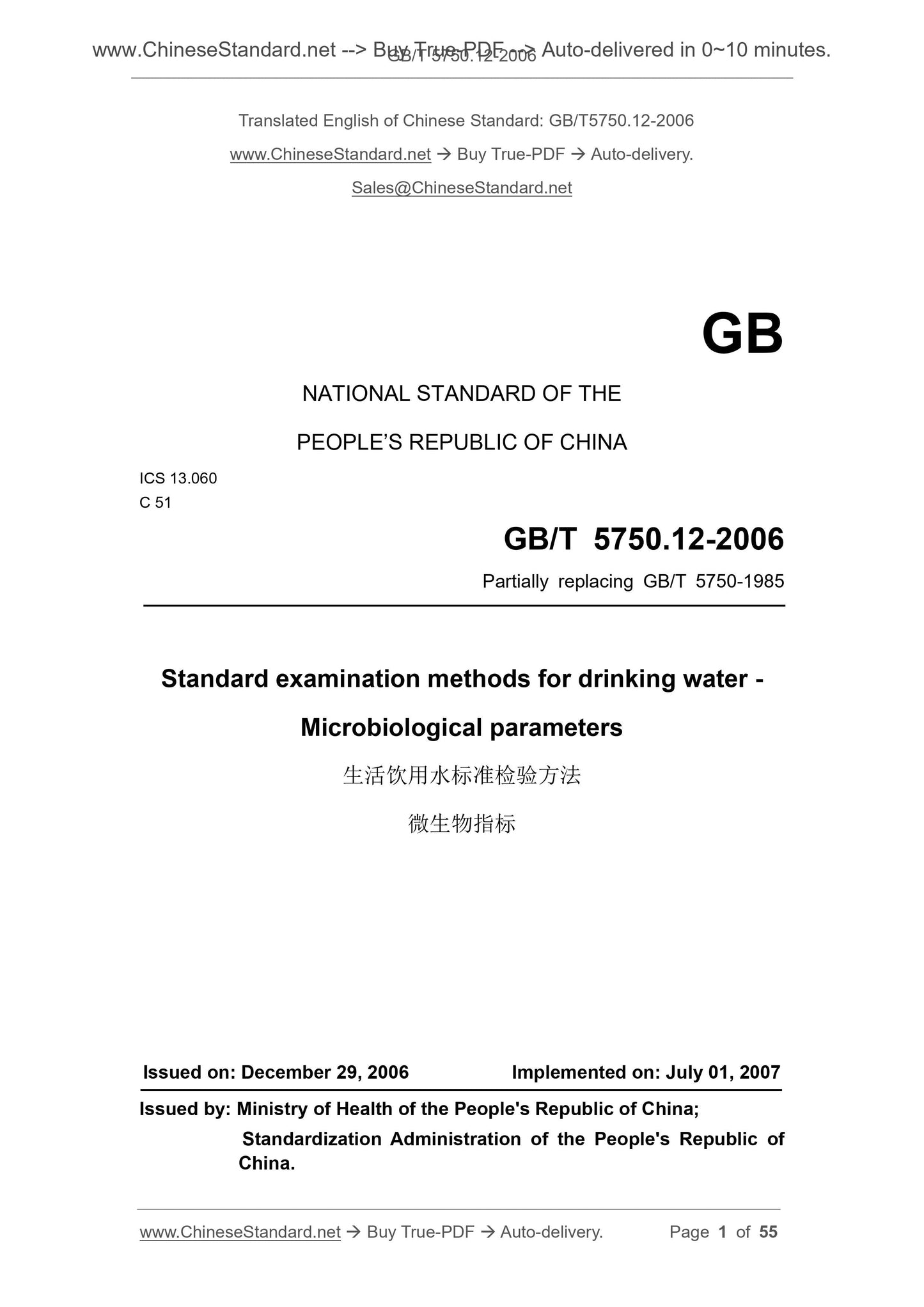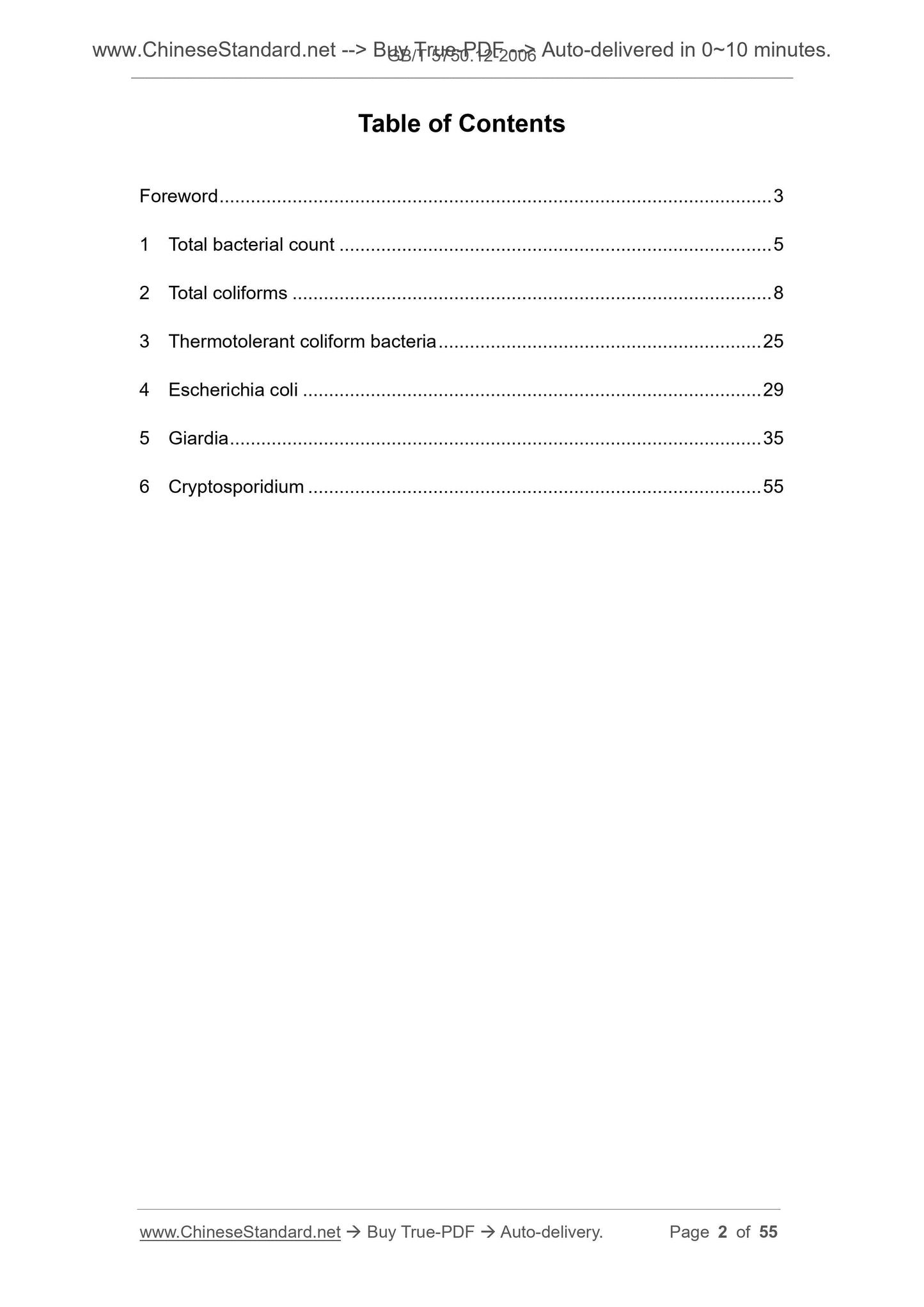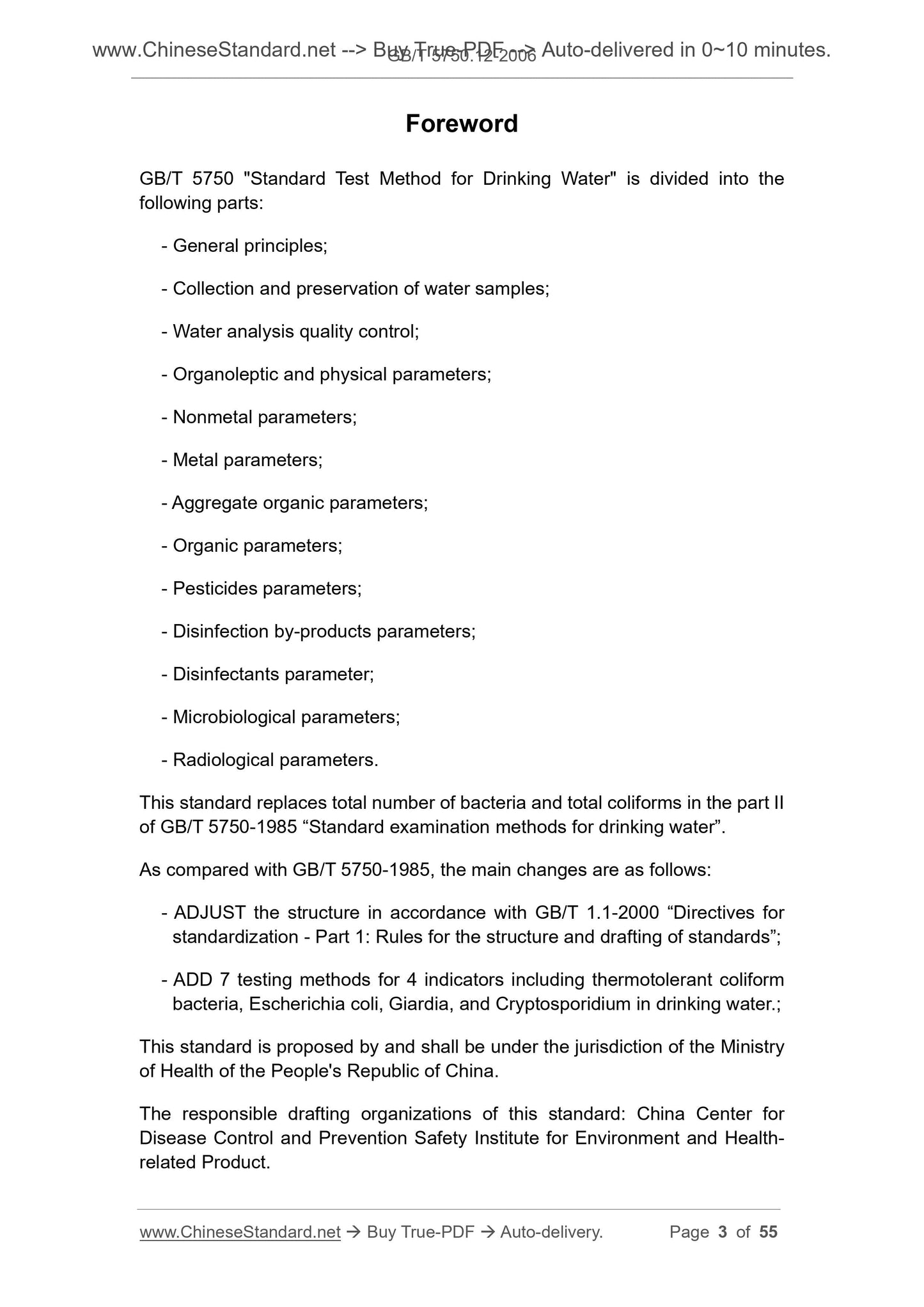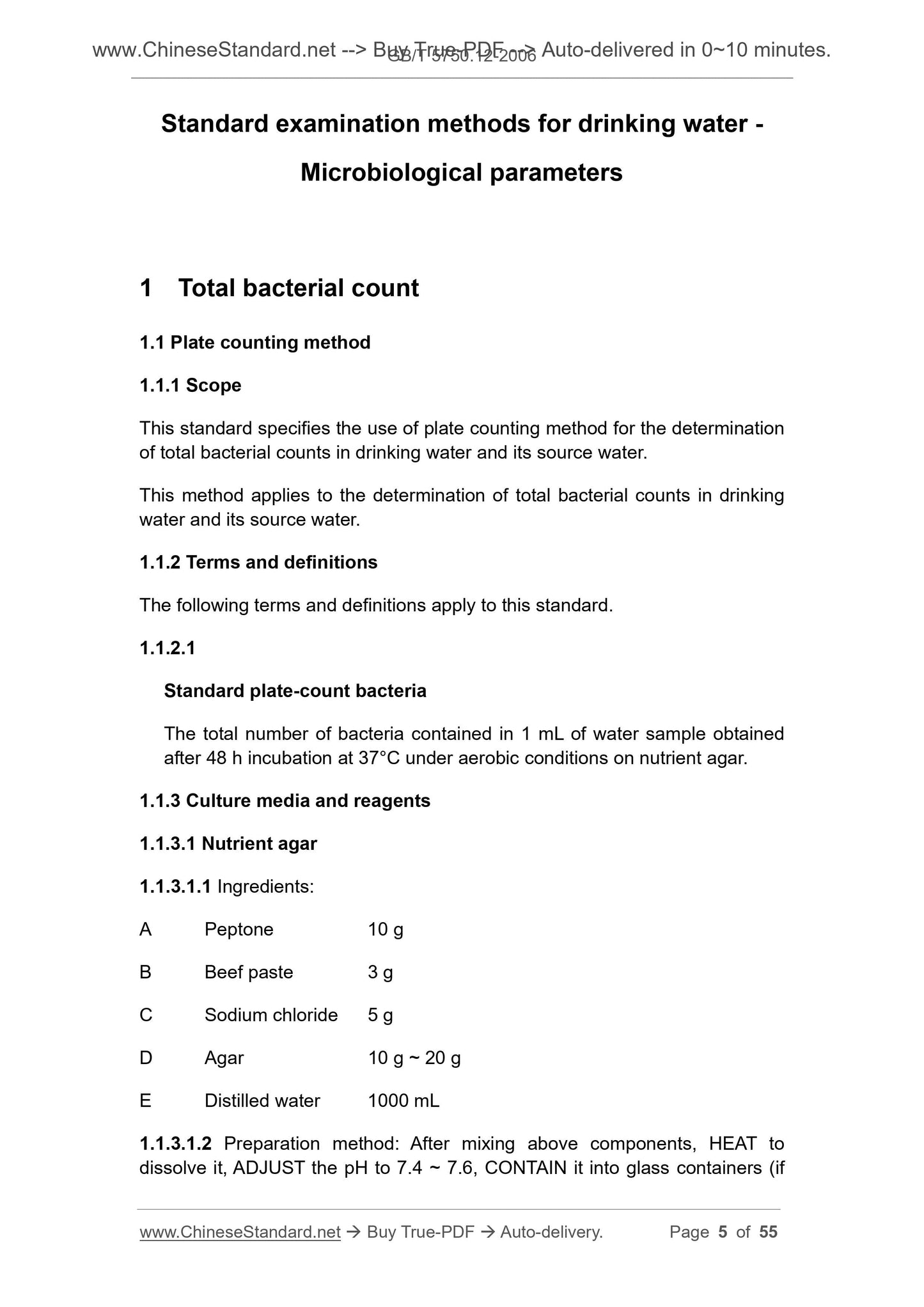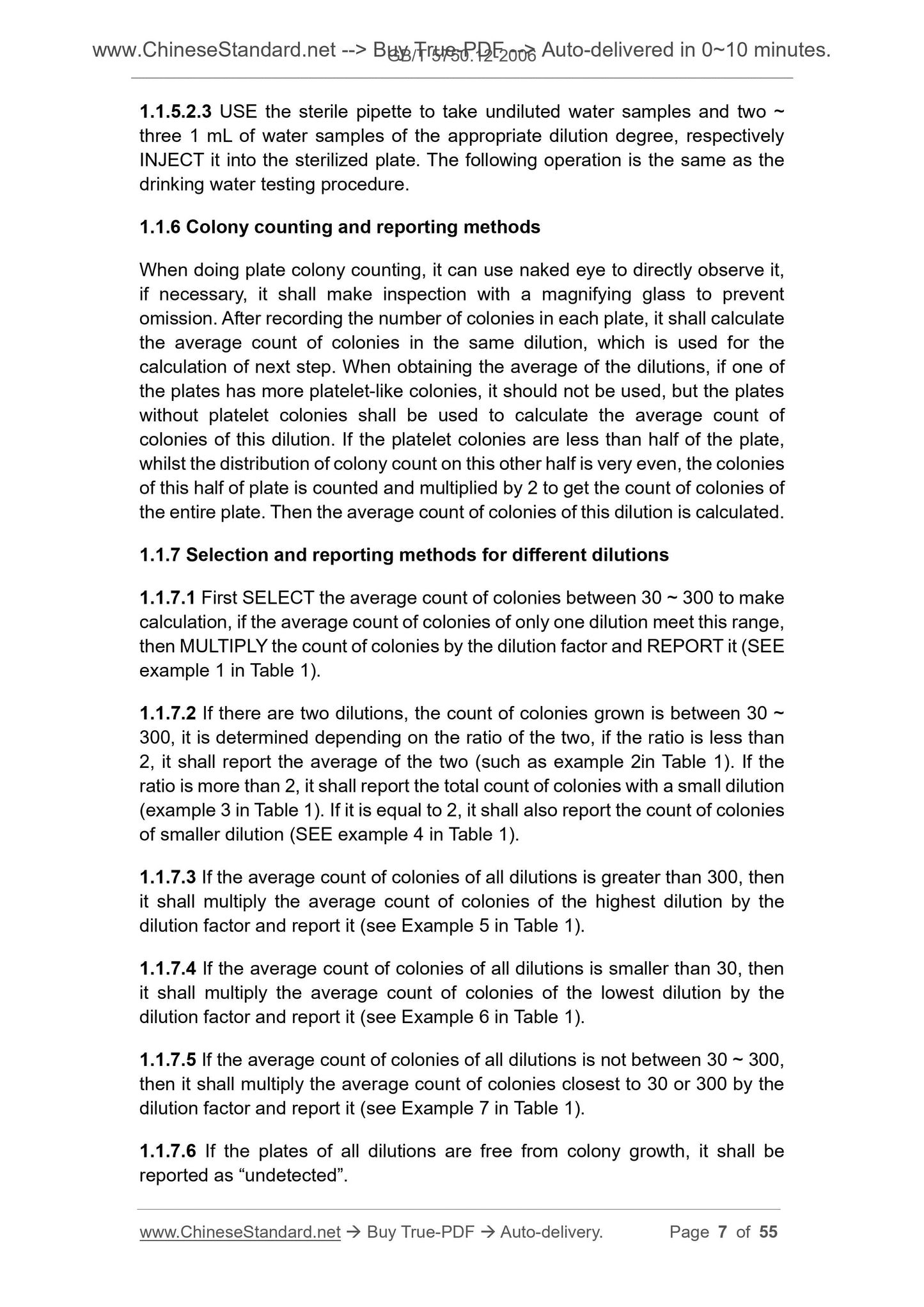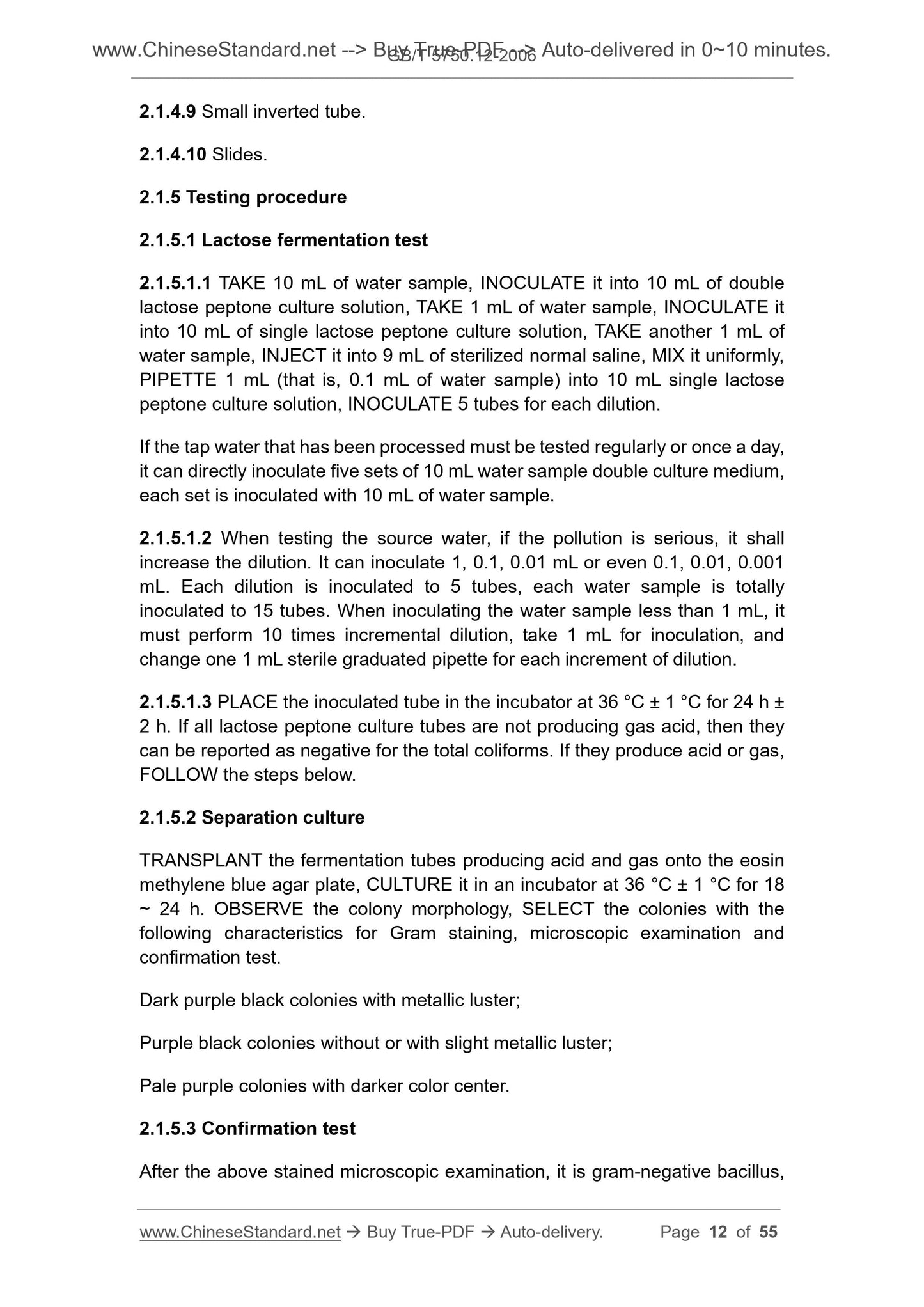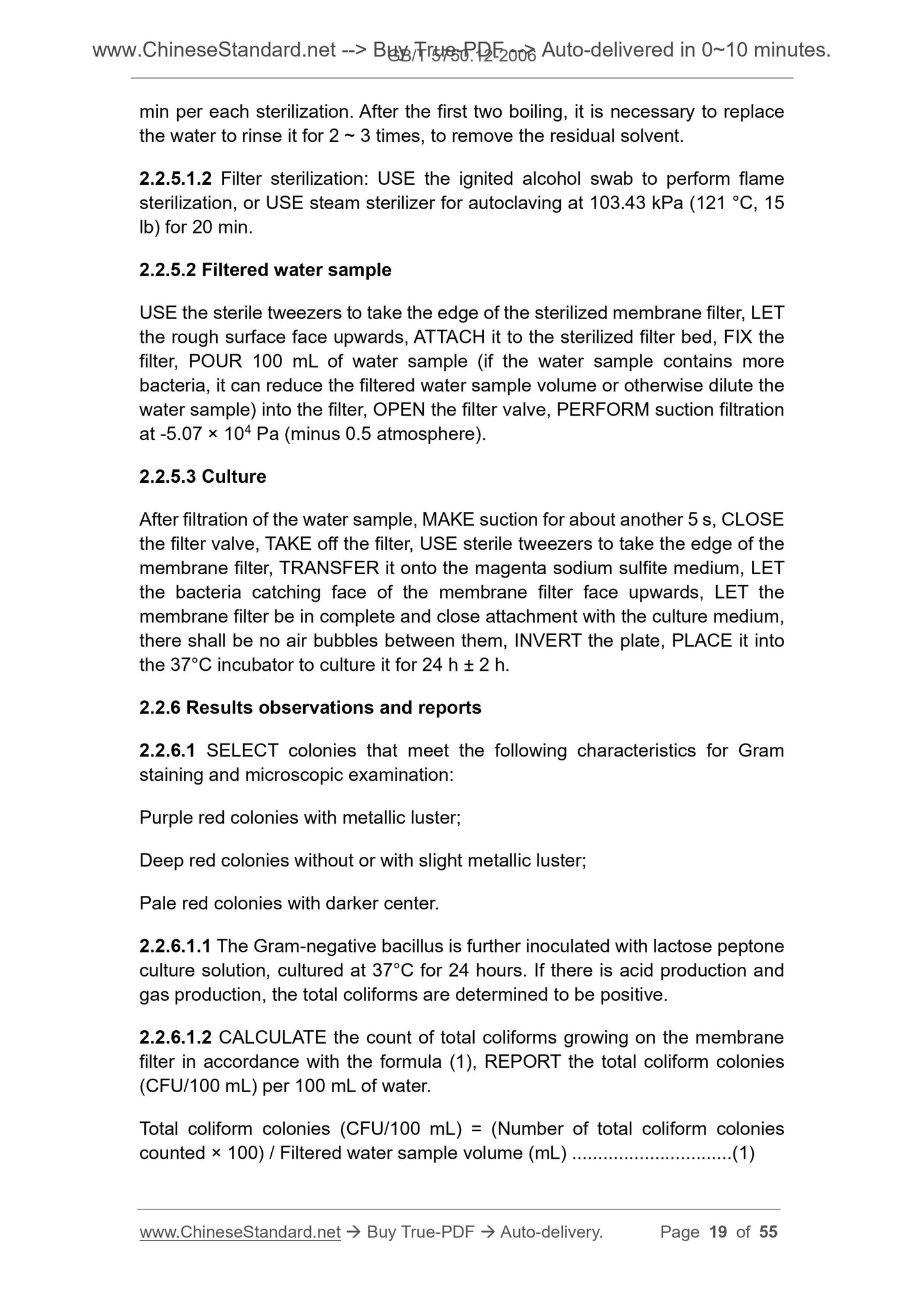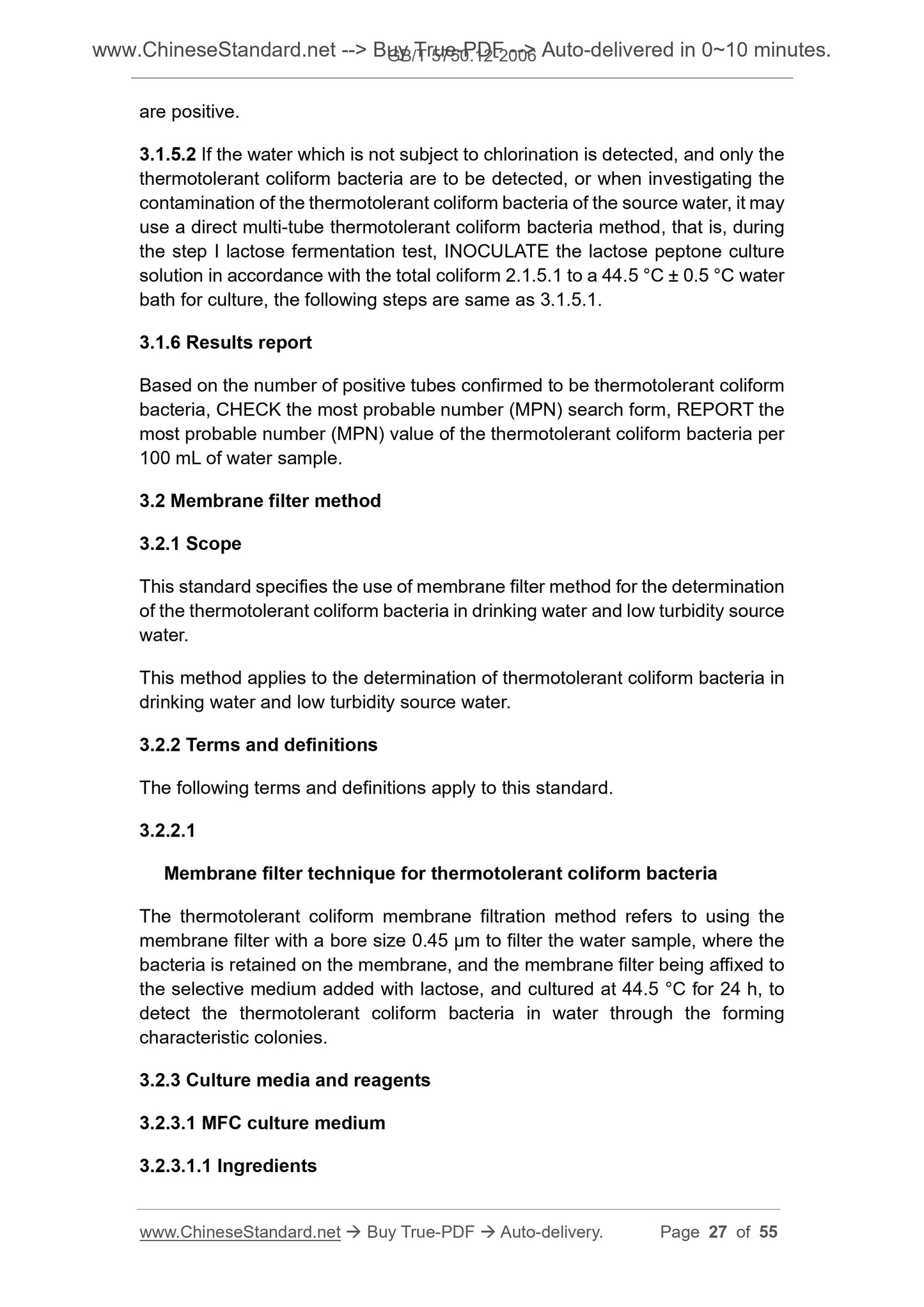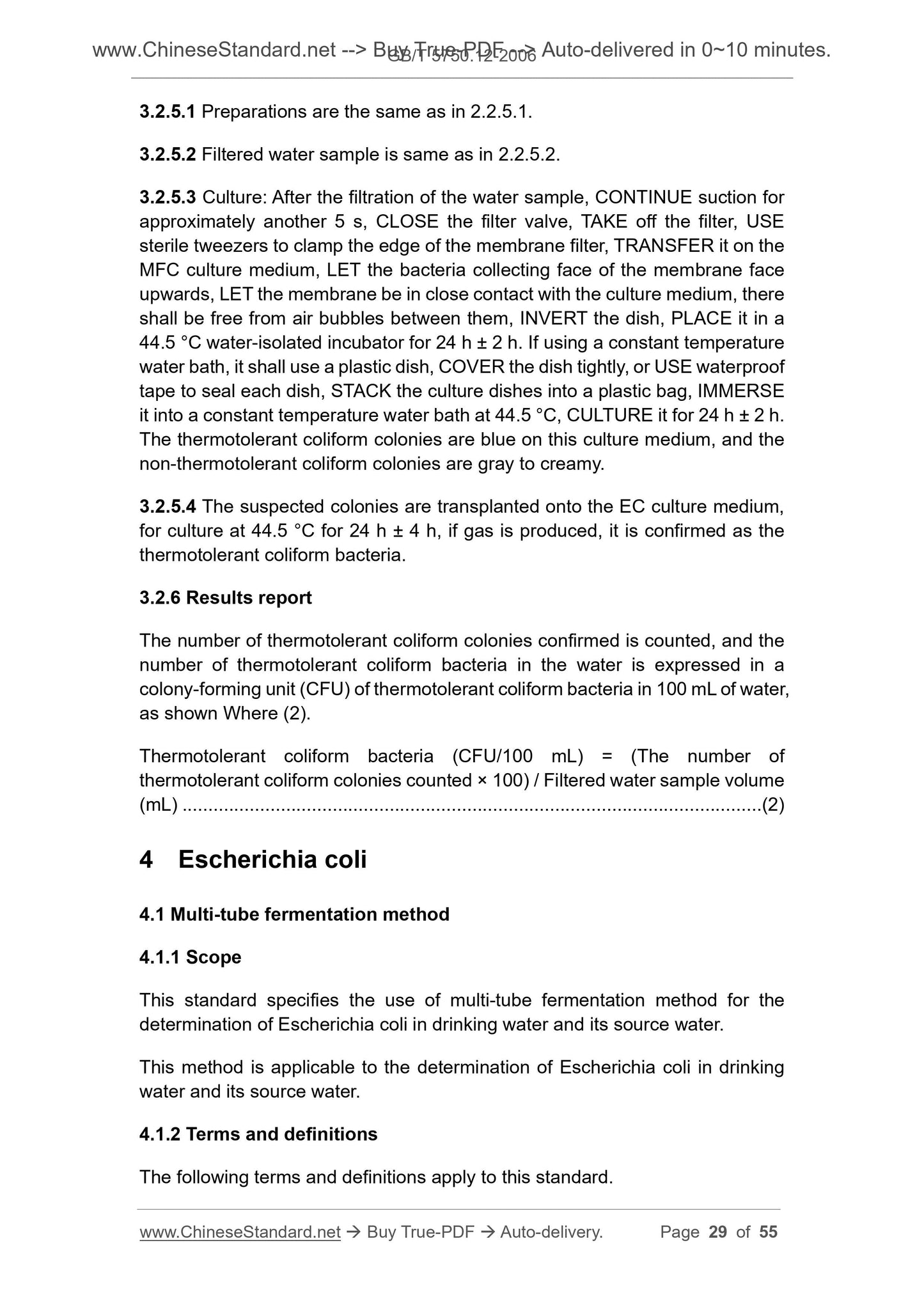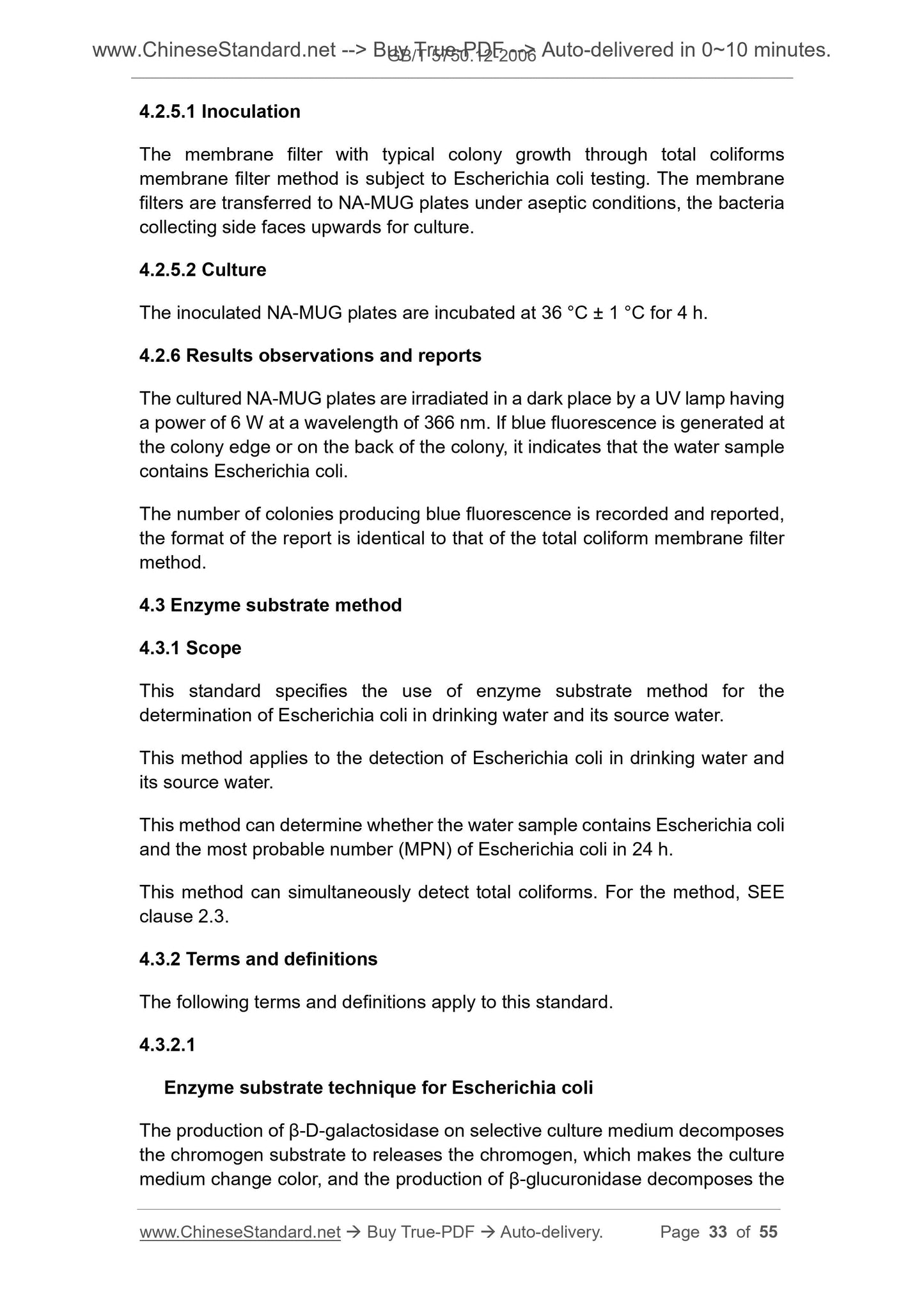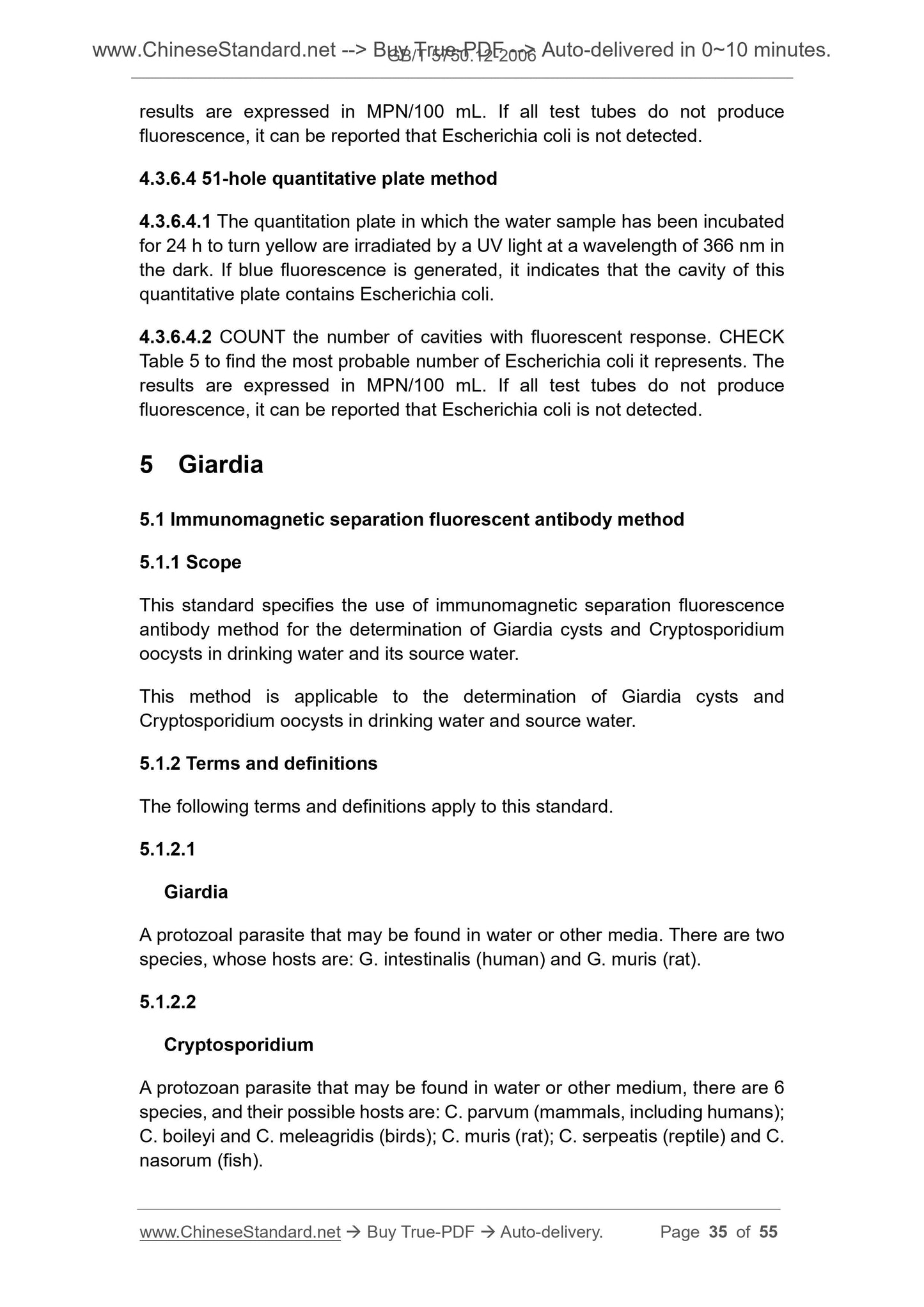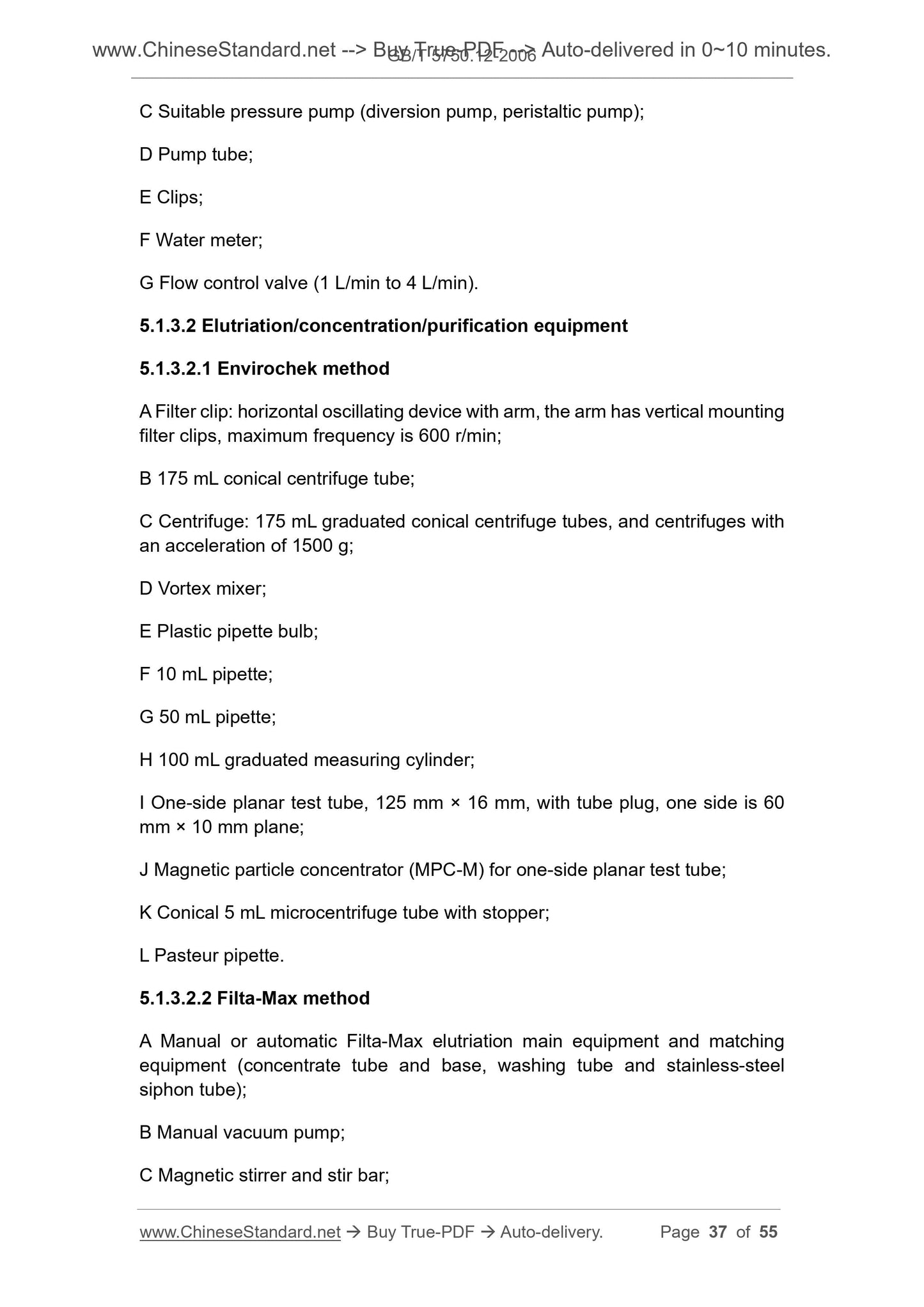1
/
of
12
www.ChineseStandard.us -- Field Test Asia Pte. Ltd.
GB/T 5750.12-2006 English PDF (GB/T5750.12-2006)
GB/T 5750.12-2006 English PDF (GB/T5750.12-2006)
Regular price
$145.00
Regular price
Sale price
$145.00
Unit price
/
per
Shipping calculated at checkout.
Couldn't load pickup availability
GB/T 5750.12-2006: Standard examination methods for drinking water -- Microbiological parameters
Delivery: 9 seconds. Download (and Email) true-PDF + Invoice.Get Quotation: Click GB/T 5750.12-2006 (Self-service in 1-minute)
Newer / historical versions: GB/T 5750.12-2006
Preview True-PDF
Scope
1.1 Plate counting method1.1.1 Scope
This standard specifies the use of plate counting method for the determination
of total bacterial counts in drinking water and its source water.
This method applies to the determination of total bacterial counts in drinking
water and its source water.
1.1.2 Terms and definitions
The following terms and definitions apply to this standard.
1.1.2.1
Standard plate-count bacteria
The total number of bacteria contained in 1 mL of water sample obtained
after 48 h incubation at 37°C under aerobic conditions on nutrient agar.
1.1.3 Culture media and reagents
1.1.3.1 Nutrient agar
1.1.3.1.1 Ingredients.
A Peptone 10 g
B Beef paste 3 g
C Sodium chloride 5 g
D Agar 10 g ~ 20 g
E Distilled water 1000 mL
1.1.3.1.2 Preparation method. After mixing above components, HEAT to
dissolve it, ADJUST the pH to 7.4 ~ 7.6, CONTAIN it into glass containers (if
1.1.5.2.3 USE the sterile pipette to take undiluted water samples and two ~
three 1 mL of water samples of the appropriate dilution degree, respectively
INJECT it into the sterilized plate. The following operation is the same as the
drinking water testing procedure.
1.1.6 Colony counting and reporting methods
When doing plate colony counting, it can use naked eye to directly observe it,
if necessary, it shall make inspection with a magnifying glass to prevent
omission. After recording the number of colonies in each plate, it shall calculate
the average count of colonies in the same dilution, which is used for the
calculation of next step. When obtaining the average of the dilutions, if one of
the plates has more platelet-like colonies, it should not be used, but the plates
without platelet colonies shall be used to calculate the average count of
colonies of this dilution. If the platelet colonies are less than half of the plate,
whilst the distribution of colony count on this other half is very even, the colonies
of this half of plate is counted and multiplied by 2 to get the count of colonies of
the entire plate. Then the average count of colonies of this dilution is calculated.
1.1.7 Selection and reporting methods for different dilutions
1.1.7.1 First SELECT the average count of colonies between 30 ~ 300 to make
calculation, if the average count of colonies of only one dilution meet this range,
then MULTIPLY the count of colonies by the dilution factor and REPORT it (SEE
example 1 in Table 1).
1.1.7.2 If there are two dilutions, the count of colonies grown is between 30 ~
300, it is determined depending on the ratio of the two, if the ratio is less than
2, it shall report the average of the two (such as example 2in Table 1). If the
ratio is more than 2, it shall report the total count of colonies with a small dilution
(example 3 in Table 1). If it is equal to 2, it shall also report the count of colonies
of smaller dilution (SEE example 4 in Table 1).
1.1.7.3 If the average count of colonies of all dilutions is greater than 300, then
it shall multiply the average count of colonies of the highest dilution by the
dilution factor and report it (see Example 5 in Table 1).
1.1.7.4 If the average count of colonies of all dilutions is smaller than 30, then
it shall multiply the average count of colonies of the lowest dilution by the
dilution factor and report it (see Example 6 in Table 1).
1.1.7.5 If the average count of colonies of all dilutions is not between 30 ~ 300,
then it shall multiply the average count of colonies closest to 30 or 300 by the
dilution factor and report it (see Example 7 in Table 1).
1.1.7.6 If the plates of all dilutions are free from colony growth, it shall be
reported as “undetected”.
2.1.4.9 Small inverted tube.
2.1.4.10 Slides.
2.1.5 Testing procedure
2.1.5.1 Lactose fermentation test
2.1.5.1.1 TAKE 10 mL of water sample, INOCULATE it into 10 mL of double
lactose peptone culture solution, TAKE 1 mL of water sample, INOCULATE it
into 10 mL of single lactose peptone culture solution, TAKE another 1 mL of
water sample, INJECT it into 9 mL of sterilized normal saline, MIX it uniformly,
PIPETTE 1 mL (that is, 0.1 mL of water sample) into 10 mL single lactose
peptone culture solution, INOCULATE 5 tubes for each dilution.
If the tap water that has been processed must be tested regularly or once a day,
it can directly inoculate five sets of 10 mL water sample double culture medium,
each set is inoculated with 10 mL of water sample.
2.1.5.1.2 When testing the source water, if the pollution is serious, it shall
increase the dilution. It can inoculate 1, 0.1, 0.01 mL or even 0.1, 0.01, 0.001
mL. Each dilution is inoculated to 5 tubes, each water sample is totally
inoculated to 15 tubes. When inoculating the water sample less than 1 mL, it
must perform 10 times incremental dilution, take 1 mL for inoculation, and
change one 1 mL sterile graduated pipette for each increment of dilution.
2.1.5.1.3 PLACE the inoculated tube in the incubator at 36 °C ± 1 °C for 24 h ±
2 h. If all lactose peptone culture tubes are not producing gas acid, then they
can be reported as negative for the total coliforms. If they produce acid or gas,
FOLLOW the steps below.
2.1.5.2 Separation culture
TRANSPLANT the fermentation tubes producing acid and gas onto the eosin
methylene blue agar plate, CULTURE it in an incubator at 36 °C ± 1 °C for 18
~ 24 h. OBSERVE the colony morphology, SELECT the colonies with the
following characteristics for Gram staining, microscopic examination and
confirmation test.
Dark purple black colonies with metallic luster;
Purple black colonies without or with slight metallic luster;
Pale purple colonies with darker color center.
2.1.5.3 Confirmation test
After the above stained microscopic examination, it is gram-negative bacillus,
min per each sterilization. After the first two boiling, it is necessary to replace
the water to rinse it for 2 ~ 3 times, to remove the residual solvent.
2.2.5.1.2 Filter sterilization. USE the ignited alcohol swab to perform flame
sterilization, or USE steam sterilizer for autoclaving at 103.43 kPa (121 °C, 15
lb) for 20 min.
2.2.5.2 Filtered water sample
USE the sterile tweezers to take the edge of the sterilized membrane filter, LET
the rough surface face upwards, ATTACH it to the sterilized filter bed, FIX the
filter, POUR 100 mL of water sample (if the water sample contains more
bacteria, it can reduce the filtered water sample volume or otherwise dilute the
water sample) into the filter, OPEN the filter valve, PERFORM suction filtration
at -5.07 × 104 Pa (minus 0.5 atmosphere).
2.2.5.3 Culture
After filtration of the water sample, MAKE suction for about another 5 s, CLOSE
the filter valve, TAKE off the filter, USE sterile tweezers to take the edge of the
membrane filter, TRANSFER it onto the magenta sodium sulfite medium, LET
the bacteria catching face of the membrane filter face upwards, LET the
membrane filter be in complete and close attachment with the culture medium,
there shall be no air bubbles between them, INVERT the plate, PLACE it into
the 37°C incubator to culture it for 24 h ± 2 h.
2.2.6 Results observations and reports
2.2.6.1 SELECT colonies that meet the following characteristics for Gram
staining and microscopic examination.
Purple red colonies with metallic luster;
Deep red colonies without or with slight metallic luster;
Pale red colonies with darker center.
2.2.6.1.1 The Gram-negative bacillus is further inoculated with lactose peptone
culture solution, cultured at 37°C for 24 hours. If there is acid production and
gas production, the total coliforms are determined to be positive.
2.2.6.1.2 CALCULATE the count of total coliforms growing on the mem...
Basic Data
| Standard ID | GB/T 5750.12-2006 (GB/T5750.12-2006) |
| Description (Translated English) | Standard examination methods for drinking water -- Microbiological parameters |
| Sector / Industry | National Standard (Recommended) |
| Classification of Chinese Standard | C51 |
| Classification of International Standard | 13.060 |
| Word Count Estimation | 34,377 |
| Date of Issue | 2006-12-29 |
| Date of Implementation | 2007-07-01 |
| Older Standard (superseded by this standard) | GB/T 5750-1985 |
| Regulation (derived from) | Chinese national standard approved by the announcement in 2006 No. 12 (No. 99 overall) |
| Issuing agency(ies) | General Administration of Quality Supervision, Inspection and Quarantine of the People's Republic of China, Standardization Administration of the People's Republic of China |
Share
